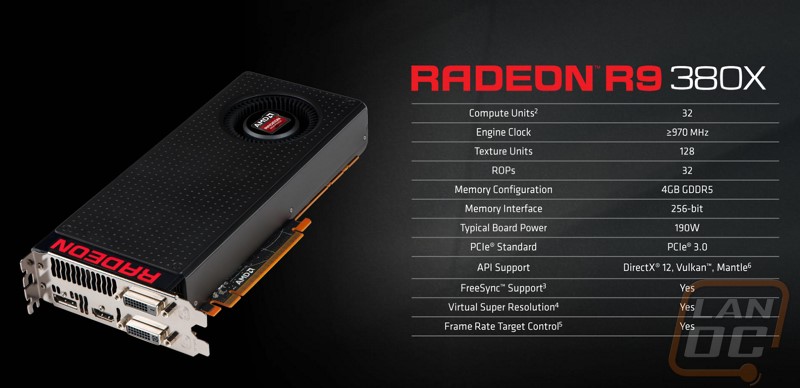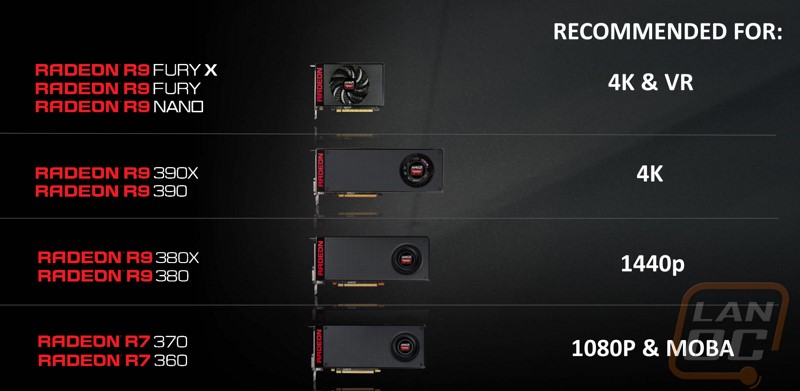When it comes to picking out a video card for your PC, I think we would all go with the top end cards if it was possible. But the truth is when we are picking out our components it is all a balance. We have to make sure that no one component gets the biggest portion of the budget, the card has to fit the budget, and it also has to fit with your other components. In other words, you wouldn’t go with a Fury if you could only afford a power supply that would power an R7 370. Because of that it is nice to have options and for the most part AMD has done a good job filling in the gaps. The one glaring omission though has been the lack of a 380X to match the 370X and 390X’s in their product line. Well today they have filled that gap. So today I’m going to dig into the Asus R9 380X Strix and find out what sets the 380X apart from the competition as well as the 380 and 390 that it sits between.
Product Name: Asus R9 380X Strix OC
Review Sample Provided by: Asus
Written by: Wes
Pictures by: Wes
Amazon Link: HERE
| Specifications | |
| Model name | STRIX-R9380X-OC4G-GAMING |
| Graphics Engine | AMD Radeon™ R9 380X |
| Bus Standard | PCI Express® 3.0 |
| OpenGL | OpenGL® 4.4 |
| Video Memory | 4GB GDDR5 |
| Engine Clock | 1030 MHz (OC mode: 1050 MHz ) |
| Memory Clock | 5700 MHz |
| Memory Interface | 256 bit |
| Stream Processor | 2048 |
| DVI Max. Resolution | 2560 x 1600 |
| DVI Output |
1x Native DVI-I 1x Native DVI-D |
| HDMI Output | 1x Native HDMI |
| HDCP compliant | Yes |
| DisplayPort | 1x Native DisplayPort 1.2 |
| Accessory Bundled |
1x STRIX Laser Sticker 1x Power Cable |
| Software Bundled | ASUS GPU Tweak 2 & Driver |
| Dimension |
273 x 140 x 43 mm 10.64 x 5.46 x 1.67 inches |
AMD 380X
Before I dive into our normal review I did want to take a look at the R9 380X and find out where it fits in AMDs product lineup as well as take a closer look at its specifications. For starters the R9 380X is based on the same Tonga GPU as the R9 380. To expand the performance, they opened things up by going from 112 texture units to 128 texture units. This raised the number of stream processors from 1792 to 2048. This puts it directly in between the R9 380 and the R9 390 with its 2560 stream processors. In fact I think the most interesting thing is that this is the same number of stream processors as the R9 280X had only it was Tahiti based not Tonga. The R9 380 and R9 380X also share the same clock speed and power usage as well. The 380X has the same 256 bit memory interface but they did double the memory capacity moving it up to 4 gigs as bump up the memory clock speed slightly as well.
| Specifications | R9 380 | R9 380X | R9 390 |
| Process | 28nm | 28nm | 28nm |
| Stream Processors | 1792 | 2048 | 2560 |
| Boost Clock | 970 MHz | 970 MHz | 1000MHz |
| GPU | Tonga | Tonga | Hawaii |
| Texture Units | 112 | 128 | 160 |
| ROPs | 32 | 32 | 64 |
| Memory Configuration | 2GB GDDR5 | 4GB GDDR5 | 8GB GDDR5 |
| Memory Interface | 256-bit | 256-bit | 512-bit |
| Memory Speed / Data Rate | 5.5GBps | 5.7Gbps | 6Gbps |
| Typical Board Power | 190W | 190W | 275W |
| CI-E Standard | PCI-E 3.0 | PCI-E 3.0 | PCI-E 3.0 |
| API Support | DirectX® 12, Vulkan™, Mantle | DirectX® 12, Vulkan™, Mantle | DirectX® 12, Vulkan™, Mantle |
| FreeSync Support | Yes | Yes | Yes |
| Virtual Super Resolution | Yes | Yes | Yes |
| Frame Rate Targeting Control | Yes | Yes | Yes |
| Launch Price | $199 | $259 | $329 |

So now that we know the difference between the 380X and the 380 and 390 above and below it lets take a look at where it fits in the product lineup. First I was curious what the overall focus of the card was. While on our call with AMD they broke down each of their cards focus in an easy to read slide so I’m including it below. Basically the 370 and 360 are 1080p and Moba focused, the 380X and 380 are 1440p, the 390 and 390X are 4K focused, and the Fury line is for 4K and VR. When I get into my testing I will be curious to see if holds up, previous testing would have me inclined to say that the 380 only worked well with lower settings on 1440p.

To get an idea of the R9 380X’s direct competition I put together a chart showing the lowest prices available currently on Newegg for each card from AMD and Nvidia. Here we can see right away that AMD has spent more time having a bigger mix that covers every price range where Nvidia has a bit of a hole above the GTX 970. That said the R9 380X doesn’t really have a direct competitor, the GTX 970 is $60 more and the GTX 960 is $50 less. When I get into testing I’m going to be focused on seeing if the 380X falls closer to the GTX 970 or the GTX 960.
| AMD | Price | Nvidia |
| $999.99 | GeForce Titan X | |
| Radeon R9 Fury X | $639.99 | |
| Radeon R9 Fury Nano | $629.99 | |
| $599.99 | GeForce GTX 980 Ti | |
| Radeon R9 Fury | $499.99 | |
| $479.99 | GeForce GTX 980 | |
| Radeon R9 390X | $379.99 | |
| Radeon R9 390 | $294.99 | |
| $289.99 | GeForce GTX 970 | |
| Radeon R9 380X | $229.99 | |
| Radeon R9 380 | $179.99 | GeForce GTX 960 |
| $139.99 | GeForce GTX 950 | |
| Radeon R7 370 | $129.99 | |
| Radeon R7 360 | $99.99 |

